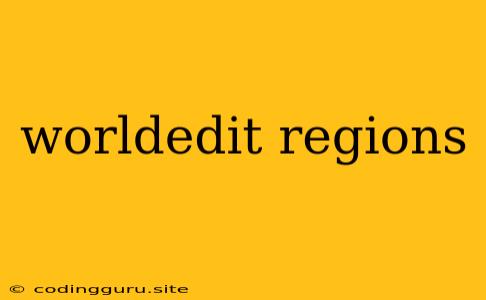Mastering WorldEdit Regions: A Comprehensive Guide
WorldEdit is a powerful plugin for Minecraft that allows players to manipulate the game world with ease. One of its most useful features is regions, which provide a way to define specific areas within the world for various purposes. Understanding how to use regions effectively is crucial for anyone who wants to take full advantage of WorldEdit's capabilities.
This guide will provide a comprehensive overview of WorldEdit regions, covering everything from the basics to advanced techniques. We'll answer common questions, offer tips and solutions, and provide practical examples to help you become a master of regions.
What are WorldEdit Regions?
Regions in WorldEdit are essentially custom-defined boundaries within your Minecraft world. They offer a way to control and manage specific areas, granting you the power to:
- Protect areas from unwanted changes: This is particularly useful for preventing griefing or preserving important structures.
- Apply specific commands to a defined area: This allows for efficient modifications, such as replacing all blocks in a region with another type.
- Control player access: You can grant specific players or groups permission to build, edit, or simply enter certain regions.
- Manage resources efficiently: Regions can be used to track and control the usage of resources like trees, minerals, or even specific blocks.
How to Create and Edit WorldEdit Regions
Creating and editing regions is a simple process once you understand the basic commands. Here's a step-by-step guide:
- Start with the //region command: This is the core command for creating and managing regions.
- Define the region's corners: You need to select two points to define the region's boundaries. Use the following commands:
//pos1- Select the first corner of your region.//pos2- Select the second corner of your region.
- Name your region: Use the
//region define <region_name>command to give your region a unique identifier. - Edit your region: Use the
//regioncommand followed by various subcommands for advanced customization.//region expand <region_name> <direction> <amount>- Extend the region in a specific direction.//region contract <region_name> <direction> <amount>- Shrink the region in a specific direction.//region move <region_name> <direction> <amount>- Move the entire region in a specific direction.
Tips and Tricks for Managing WorldEdit Regions
- Use descriptive names: Choose names that clearly indicate the purpose or location of the region for easier identification later.
- Organize your regions: Consider creating a system for naming your regions to make it easier to navigate and manage them, especially if you have a lot.
- Utilize region flags: Flags offer fine-grained control over what players can do within a region. Some useful flags include:
build- Controls whether players can place or break blocks.use- Controls whether players can use items like chests or beds.interact- Controls whether players can interact with entities.
- Experiment with different region types: WorldEdit allows for different region types, such as cuboids, spheres, or ellipsoids. Explore these options to find the best fit for your needs.
Practical Examples of WorldEdit Regions
Here are some real-world applications of regions to illustrate their versatility:
- Town Protection: Create a region around a town or city to protect it from unwanted changes or griefing.
- Resource Management: Designate regions around areas with specific resources, like a mine or a forest, to control how they are used.
- Player Housing: Create regions around individual player houses to ensure privacy and control over modifications.
- Event Areas: Set up regions for events like battles or competitions to manage the environment and player interaction.
Troubleshooting Common Region Issues
- Conflicting regions: If you encounter overlapping regions, you may face unexpected behavior. Ensure that your regions don't intersect or use the
//region mergecommand to combine them. - Permission errors: Make sure you have the necessary permissions to create and edit regions. Check your WorldEdit configuration file for any limitations.
- Incorrect commands: Always double-check your commands for typos or errors in syntax. The
//helpcommand can be helpful in finding the correct syntax for various region commands.
Conclusion
WorldEdit regions are a powerful tool for anyone looking to manage and customize their Minecraft world effectively. By understanding how to create, edit, and utilize regions, you can enhance your gameplay experience, prevent unwanted changes, and create unique and memorable structures. Practice these techniques and you'll be well on your way to becoming a true master of WorldEdit regions.
